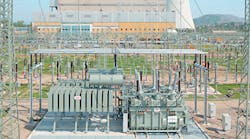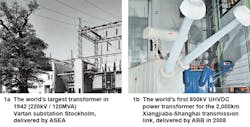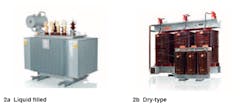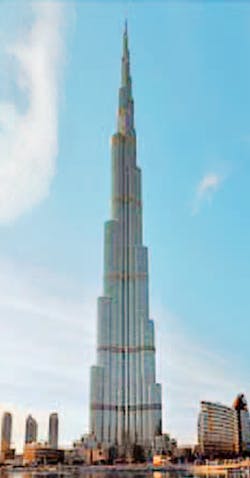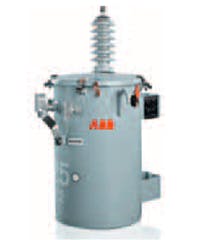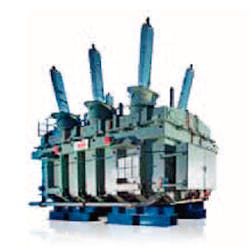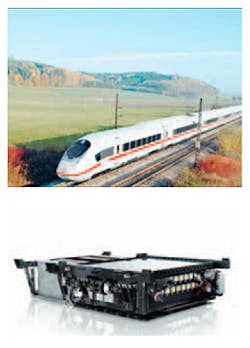Around 130 years ago a technical revolution took place that was to be a vital step in the development of modern society. That revolution was the commercial generation, transmission and usage of electrical energy. Nobody today can imagine a world without electricity. However, this article will start by taking the reader back to the early days when pioneers like Thomas Edison and George Westinghouse – and their ideas – were competing for the transmission system of the future: Should it be DC or should it be AC?
Very early electrical installations were local: The sites of generation and consumption were at most a handful of kilometers apart: Direct connections from the steam- or hydro generators to the consumers were in the range of hundreds of volts. In the early 1880s, for example, the "Edison Illuminating Company" supplied 59 customers in Lower Manhattan with electricity at 110 V DC. But the energy demand of the fast growing cities and industrial centers called for an increase in power transmission capability.
The small steam- and hydro generators were no longer sufficient and larger power plants were erected more remotely from the cities. Voltage levels had to be increased to keep nominal currents on the power lines moderate and reduce losses and voltage drops. This was the time of the birth of a new component: the power transformer. In a transformer, two coils are arranged concentrically so that the magnetic field generated by the current in one coil induces a voltage in the other. This physical principle can only be applied in AC systems, as only a time-varying magnetic field is able to induce a voltage. By using a different number of winding turns in the two coils, a higher or lower voltage can be obtained. The ability to transform from one voltage level to another one was the main reason for the breakthrough of AC three-phase transmission and distribution systems. These AC systems operate at a frequency high enough that human short perception does not see the time variation ("flickering") and low enough that switching equipment can be operated safely. The best compromise was the well-known 50 or 60 Hz of the today's mains supplies.
Transformers need an "amplifier" for the magnetic field so that the number of winding turns can be kept low. This "amplifier" is the so-called magnetic core. It consists of ferromagnetic iron, which contains microscopic elementary magnets that align to the transformer's magnetic field as a compass needle aligns to the Earth's magnetic field. The iron core is made of many thin ferromagnetic steel sheets that are electrically insulated against each other and stacked. This reduces classical eddy losses. The use of special alloys and manufacturing methods enables a minimum needed energy to change polarity of the elementary magnets.
This basic physical principle of transformers is still the same today as it was 130 years ago, but energy density, efficiency, costs, weight and dimensions have drastically improved. This can be compared to the history of cars and the internal combustion engine: Here too the basic principle has remained unchanged in 100 years, but technical progress has transformed the scope of possibilities almost beyond recognition. During the first decades of electrification, the main focus in transformer research and development was to increase power capacity (the power that can be transmitted by one unit). Furthermore, more and more effects concerning voltage transients became known that could endanger the transformer's insulation. These include resonance effects in the coils that can be triggered by fast excitations such as the overvoltage impulse of a lightning strike. New coil designs mitigated these resonance effects.
Transformers are the main current-limiting element in case of short-circuit failures in the transmission system. The so-called stray reactance, which represents the magnetic flux outside of the magnetic core limits the increase in current in such an event. If high currents flow through the coils uncontrolled, mechanical forces try to press the coils apart, and may cause damage if the construction is not sufficiently robust.
Due to the resistance and inductance of the power lines themselves, the voltage level may vary depending on load conditions. This means that less voltage "arrives" at the receiving end of a power line when the load is high. To keep the voltage level within an acceptable range, power transformers usually include an on-load tap changer to vary the number of active winding turns of coil by switching between different taps. In medium voltage (MV) distribution, this is usually done offline: This means the tap changers are adjusted once before the transformer is energized and then remain fixed.
1 Transformer development
The increasing importance in recent decades of UHV (ultra-high voltage) DC transmission lines for high power transmission over very long distances (greater than 1000 km) has made it necessary to develop UHV-DC converter transformers, which are a huge challenge especially for the electric insulation system. The 800 kV UHV-DC Xiangjiaba-Shanghai line ➔ 1, for example, has a capacity of up to 7200 MVA, which is roughly comparable to the consumption of Switzerland.
2 Distribution transformers come in two main categories
On the distribution level (transmitted power up to 10 MVA) there are two main categories of transformers ➔ 2: Liquid filled (using mineral oil or replacement fluids such as synthetic or natural esters) and dry type. The liquid filled transformers are the most compact and cost efficient solution, whereas dry type transformers are preferred in environments where fire safety is of special importance such as, for example, underground substations, mining sites, marine and some industrial applications ➔ 3, 4.
Standard versions of distribution transformers are cooled passively as the heat generated by losses is transported away from the core by natural convection of the insulation medium. In the case of liquid filled products, this heat is then transported through the tank walls by thermal conduction and removed by the natural or forced convection of air. Dry transformers in closed environments usually have a forced internal convection flow of air to ensure sufficient cooling of the transformer core.
4 Single-phase pole-mounted transformers, for small power classes up to 167 kVA
AMDT (amorphous metal distribution transformers) is an upcoming technology that reduces losses inside the magnetic core. Although the amorphous materials are still more expensive than standard grain oriented steel, their application can be justified depending on how these losses are capitalized over the lifetime of the transformer.
Power transformers
When the transmitted power exceeds around 10 MVA, special designs are required to cope with the mechanical forces of short circuit currents, higher insulation levels and increased cooling requirements. For these ratings, liquid-filled transformers are usually used. The insulation between the windings becomes more and more demanding at higher voltages. Furthermore, resonance effects inside the winding itself have to be considered to avoid insulation failures during highly dynamic impulse stresses such as lightning strikes which may reach amplitudes of one to two thousands kilovolt with a 1 μs rise time.
Transformers with power ratings above some ten MVA are a key element in the supply of large regions or industrial areas. As a rule of thumb, it can be considered that one person has an average electrical power demand of 1 kVA, which means, that a 400 MVA transformer transfers the power needed by 400,000, the equivalent of a medium sized city. Such transformers have to comply with special requirements on safety and reliability and also have to provide a very high efficiency and low sound level. In recent decades, high voltage DC lines have also become increasingly important, especially in large countries such as China where they connect industrial centers to the remote regions where the electricity is generated. ABB now offers standard solutions for DC converter transformers for up to ± 800 kV DC.
A transformers located directly next to a power plant is called GSU (Generator Step-up Unit). A GSU transforms the electric power from the medium voltage of the generators to the high voltage transmission level.
To balance power flow between parallel power lines, phase shifters can be used. These are transformers (usually with a 1:1 translation ratio) that adapt and control the phase angles of voltage and current to optimize the power transmission capacity of the lines. Phase shifters exist up to a power rating of 1,500 MVA ➔ 5.
Today transformation efficiencies of up to 99.85 percent are achievable by using special magnetic steel qualities and optimized designs. The heat losses, even at these high efficiencies, are still significant: For the 400 MVA unit mentioned above, for example, it would be still around 600 kW under full load conditions. The cooling system thus remains a challenge. Additionally, the weight and size of such devices has to be dimensioned carefully since there are limitations in the maximum transportation possibilities in the different countries ➔ 6.
|
6 ABB is the world's largest transformer manufacturer and service provider, capable of delivering high-quality durable products and services all over the world ABB transformers are found wherever electricity is generated, transported and consumed – in power plants and substations skyscrapers and shopping malls, ships and oil platforms, locomotives and railway lines, wind parks and solar fields, water and wastewater plants. The world's tallest building, the 828 meters high Burj Khalifa in Dubai is equipped with 78 dry-type ABB transformers to ensure power reliability ➔ 3. The nearby Dubai Fountain, which is illuminated by 6.600 lights and shoots water 150 meters into the air, is also equipped with ABB transformers. For almost 120 years, ABB has produced commercial transformers and continued to enhance them by developing new technologies and materials that raise efficiency, reliability and sustainability to a new level. ABB has set the world records for the most powerful many times – from the world's first transformers of 400 kV and 800 kV in the 1950s and 1960s, to the most powerful UHVDC transformers for the 800 kV, 2000 km Xiangjiaba-Shanghai transmission link in China ➔ 2. By developing new high-performance materials and using fire-resistant insulation liquids, ABB has improved the efficiency, safety and environmental friendliness of transformers. The new eco-friendly product lines can achieve energy savings of 40 – 50 percent. |
Traction and special transformers
Railway vehicles use a special type of transformer that must be highly compact, reliable and robust. Operating frequencies vary (according to countries and systems) from 16.7 Hz to 60 Hz with power classes of up to 10 MVA. To permit trains to cross borders between countries, traction transformers must be compatible with the different frequencies and power systems. ABB offers optimized solutions for all these different railway applications, stretching up to high speed trains with their challenging needs ➔ 7.
Moreover, ABB makes a variety of further transformers for special applications, for example for subsea electrification or for operating variable speed drives. 7 ABB is supplying the traction transformer for the new "Velaro D" high speed train
Max Claessens
ABB Power Products, Transformers
Zurich Switzerland
[email protected]
